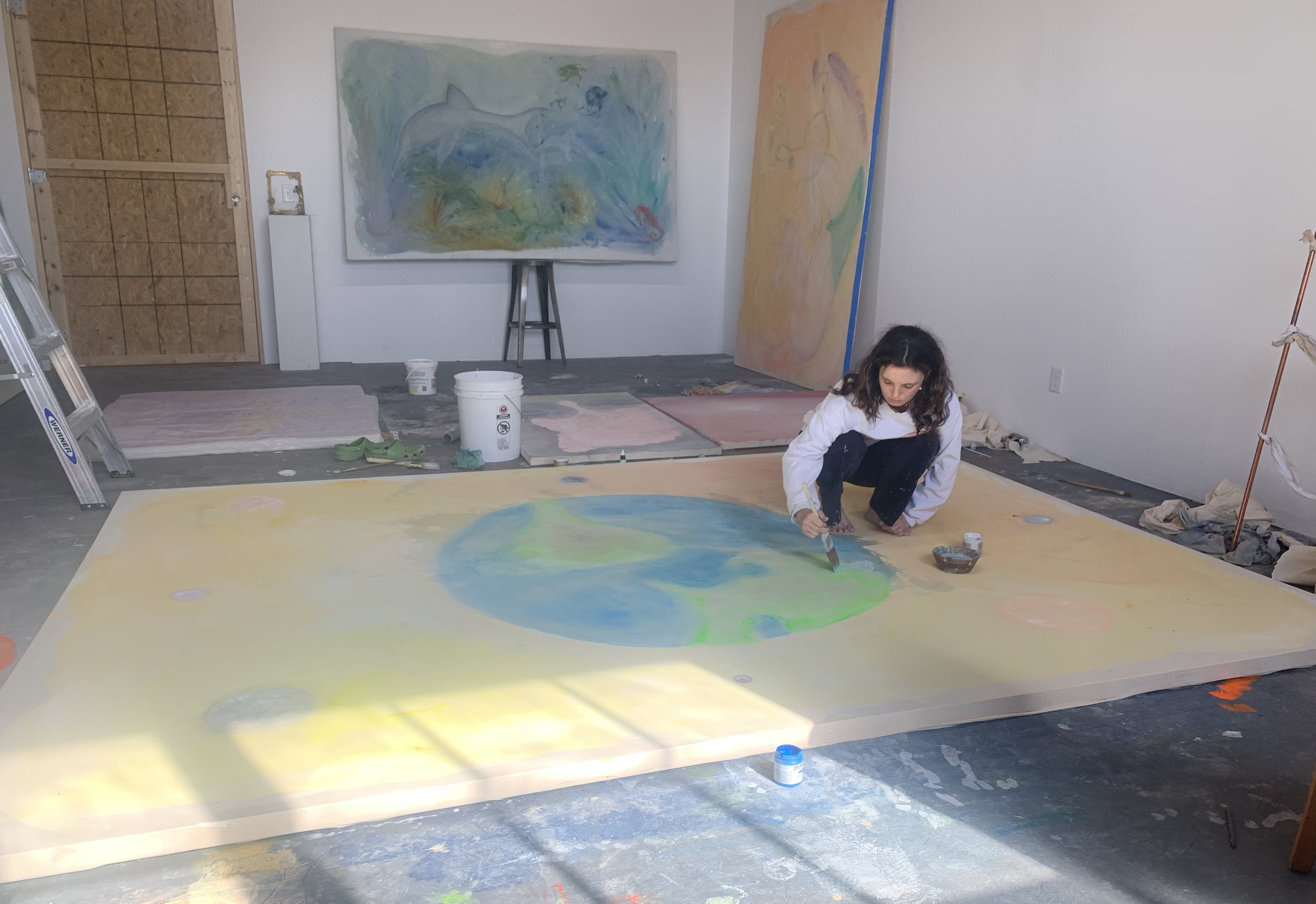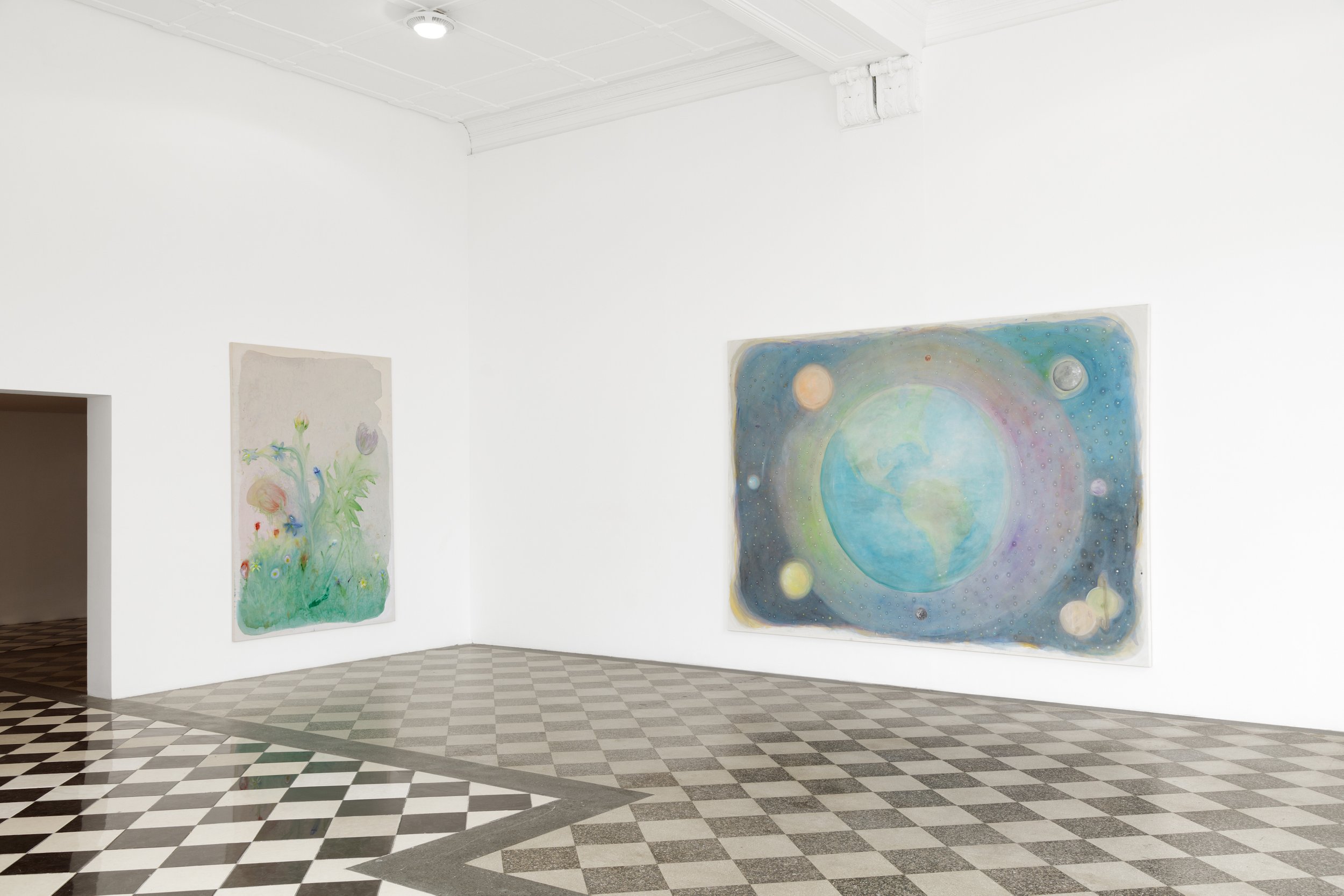Interview with Artist Tara Walters on Her Recent Exhibition, “Dropping In,” at Kristina Kite Gallery
Artist Tara Walters in her studio. Photo courtesy of the artist.
Los Angeles-based artist Tara Walters spoke with us about her recent exhibition, Dropping In, at Kristina Kite Gallery.
The title of the show, Dropping In, brings to mind this idea of tuning into something outside of the realm of the conscious mind. Can you share about this and the process of how you work?
Its so wonderful to see this question given that we met at one of Mary’s psychic circle cacao ceremonies. The term dropping in comes from a class that I took last fall with Mary on psychic development. Dropping in is as you state above about tuning in and entering into a deep state where the mind and imagination meet. Through this space a world begins to appear and when I see a scene in this world I decide to paint that image. I never really know why I paint what I paint but I believe in the process and know that the meaning will unfold along the way.
Installation image of Dropping In. Courtesy of the artist and Kristina Kite Gallery.
The way that you describe your process sounds like the painting is revealing itself to you as you go, just as much as you are controlling what occurs on the canvas. To what degree are these paintings a result of co-creation? How does your spirituality play into the work you create?
Ever since I was very young I had a strong connection with one of Maryland’s State Parks in my backyard which connected to a horse stable down the road. I would wander these woods and get lost finding worms and bugs and droplets on leaves, and then I would walk a half a mile down the road to work at a barn where I would talk with the horses and help whisper the ones rescued at auction and the race tracks. I think these moments really had me in-tune with the same connection I have practicing psychic work. It's the ability to feel, see, hear and smell clearly to a point where the noise around us drops and I enter into a state of clarity. It's interesting becuase I tend to paint the same types of worlds that I remember dreaming about as a child. There is a connection to my childhood within the work but it goes beyond that point to where its a place that still brings me serenity as an adult. I find this same connection in the impressionists who adored gardens and were lost in the mysticism of nature.
You have a unique practice of incorporating the natural elements as part of your medium. Can you share more about that?
The idea of using natural elements began when I was 23 years old living in Savannah reading André Breton about the technique of fumeage, painting with fire. I loved the idea of being able to use a natural element in the work other than the paint that already consisted of bits of earth materials. I feel using a natural element in its raw form allows for another entity to come into the work, as if I am working with an old friend. When I moved to LA I stopped using fire and decided to incorporate ocean water into the work. It wasn’t until I saw my entire studio floor sparking that I realized how to work with the material. And now I know exactly what needs to happen in order to create those same crystallized sparkles onto the canvas. These little moments remind me to slow down and take in the magic that is all around us and how the world is such a wondrous place.
Installation image of Dropping In. Courtesy of the artist and Kristina Kite Gallery.
Tara Walters. Barn Cat. Courtesy of the artist and Kristina Kite Gallery.
Color appears to be an important aspect of your work. How do you arrive at the colors on the canvas?
I tend to paint in a similar way as Helen Frakenthaler, paints that are watered down and used to dye the fabric. I paint in layers which allow for a sort of glass like appearance to form within the work. The colors before they are on the canvas are basic yellow, blue, green, etc sometimes more of an olive green or phthalo green, the colors are all the same because of the process and how many layers it takes to create an image.
In its depiction of plants, animals, and traces of humankind, your work reminds us of the connectedness between all forms of life and sometimes even the exchange that occurs between them. Can you speak to this a bit more, especially with regard to particular works like Barn Cat?
Barn Cat is a very special piece because it’s about the hidden relationship between animals. I started riding horses when I was five and by the time I was eight I would walk to the barn in the summer and on the weekends, and on school days, dropped off after completing my homework. When I was there I would see the mice scurry around and the riders bring their dogs, but the one thing that was not brought there and would always be in the stalls with the horses hanging out were CATS! At the time I thought nothing of it, but as I have recently started riding horses again, post graduating ArtCenter, the memory returned and I had to paint this relationship between horses and cats, as different as they are, they are the best of friends and not many would know it.
There’s been a rise in popularity and visibility of women artists whose work taps into a higher dimension or invisible worlds, particularly with artists like Hilma af Klint, Agnes Pelton, Leonora Carrington and so forth. Do you feel there’s a particular connection between the feminine energy and the spirit or divine?
Thank goodness for this resurgence because a few years ago during my undergrad at SCAD this topic was very unpopular. I remember people laughing at my connection with mysticism and art. I was so confused why no one else understood the importance of it given that it was the precursor to abstract art and the impetus for many of the surrealist paintings. The idea of a higher dimension and invisible world is the ability to connect to one’s deep imagination and to dream. I believe there is a connection between the unconscious and the conscious and the ability to tap into the unconscious consciously. And that ability is where I believe great art is formed; the art that is not simply a person putting their idea onto the canvas, but working with the canvas, and working with the material and staying in that trance state of imaging where one can connect to a world beyond one they thought they could reach. I think this process is sacred and everyone has the ability to tap in to it, it's just the patience and agility to work ones way through the canvas and into that world.
Lastly, what do you hope people get from viewing your work?
I hope people remember the past and believe in the future.
For more information on artist Tara Walters, please visit tarawalters.com.



